Drum programming is a fundamental component of modern music production across almost all genres, from hip-hop and dance music to rock and country.
It involves creating rhythmic patterns and beats using a combination of digital software or hardware like drum machines.
Essentially, drum programming is the backbone of your track 一 dictating the pace, groove, and overall feel of your music.
However, not doing it correctly can leave your music feeling lifeless and off-balance.
A poorly programmed drum can disrupt the flow of a track, while an overly complicated pattern might distract from the melody or other elements.
But, fear not, because we’ll be breaking down all the vital aspects of drum programming so you’ll be a master in no time.
In today’s article, we’ll be covering:
- What drum programming is & why it’s so important ✓
- Creating your own complex drum patterns ✓
- Mastering the kick & snare drum ✓
- Hi-hats and cymbals ✓
- Understanding & using syncopation ✓
- The importance of mixing in drum programming ✓
- So much more ✓
By the end of this guide, you’ll have a solid understanding of drum programming.
Therefore, you’ll be equipped with the knowledge to craft dynamic, engaging beats that can truly elevate your music.
So, let’s dive in…
Table of Contents
- What is Drum Programming?
- How To Program Drums
- Drum Sounds: Breaking It Down
- Drum Kits
- Drum Programming Basics
- Hip-hop Drum Programming
- Further Mastering the Kick Drum & Snare Drum
- Hi-Hats & Cymbals: Giving Life to Your Drum Patterns
- Understanding & Using Syncopation
- The Art of Drum Loop Variation
- The Importance of Mixing in Drum Programming
- Final Thoughts
What is Drum Programming?
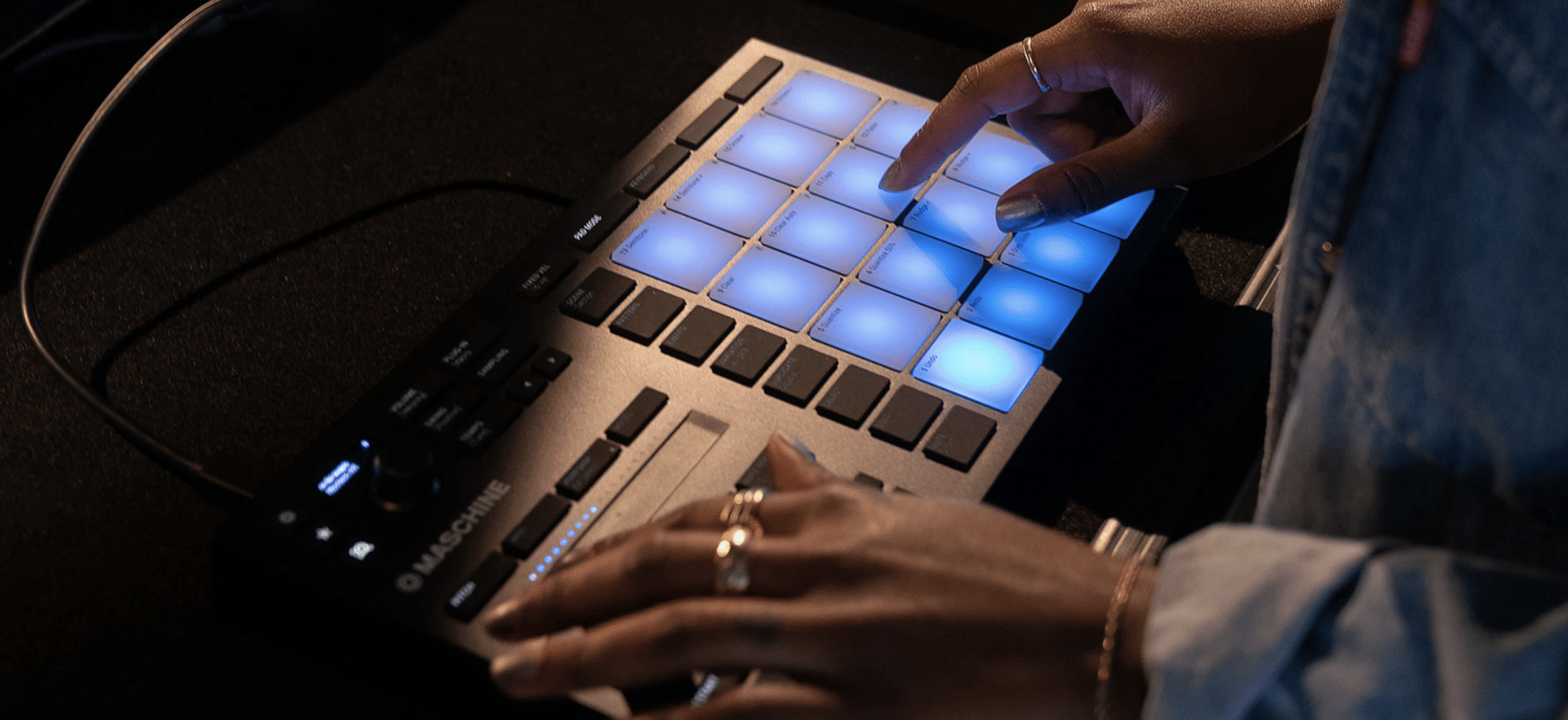
Drum programming is the art of creating drum patterns and rhythms using software or hardware like drum machines.
With drum programming, you can create complex drum patterns that give life to a track, driving its rhythm and shaping its mood.
But don’t let the term “programming” intimidate you…
It’s not about writing code or extremely complex algorithms.
At its heart, drum programming is about arranging drum sounds in ways that make people want to move.
It’s about taking drum sounds (kicks, snares, hi-hats, cymbals, etc.) and turning them into a rhythmic tapestry that serves as the backbone of a track.
One thing that I love about drum programming is how it opens up a world of possibilities for modern music.
With drum programming, you’re not limited by the physical constraints of a traditional drum set.
You can experiment with a wide variety of:
- Drum sounds
- Textures
- Rhythms
- Etc.
This way, you can create unique and compelling drum patterns.
How To Program Drums

Drum programming is more than just making beats; it’s a cornerstone of the music production process.
It’s the rhythmic foundation of a track, as it:
- Sets the tempo
- Creates the groove
- Drives the energy of the music
From the pulsating beats of hip-hop to the driving rhythms of tech-house, drum programming plays a pivotal role in defining the character and feel of a song.
But it’s not just about laying down a beat 一 drum programming is also about creating unique drum patterns that set your music apart.
With drum programming, you can infuse your personality into your music and create beats that are distinctly you.
It’s about breaking away from conventional drum patterns and exploring new rhythmic territories.
Another reason why drum programming is so important is its influence on the listener’s experience.
It can create a sense of anticipation, excitement, or relaxation.
Through drum programming, you can control how people react and feel when they listen to your music.
So whether you’re a seasoned producer or just starting out, mastering the art of drum programming is key to successful music production.
Drum Sounds: Breaking It Down
Before we dive into the nitty-gritty of drum programming, let’s take a moment to understand the building blocks of drum sounds.
Each drum sound serves a specific purpose in creating a rhythm, and understanding these roles is key to effective drum programming.
-
The Kick Drum
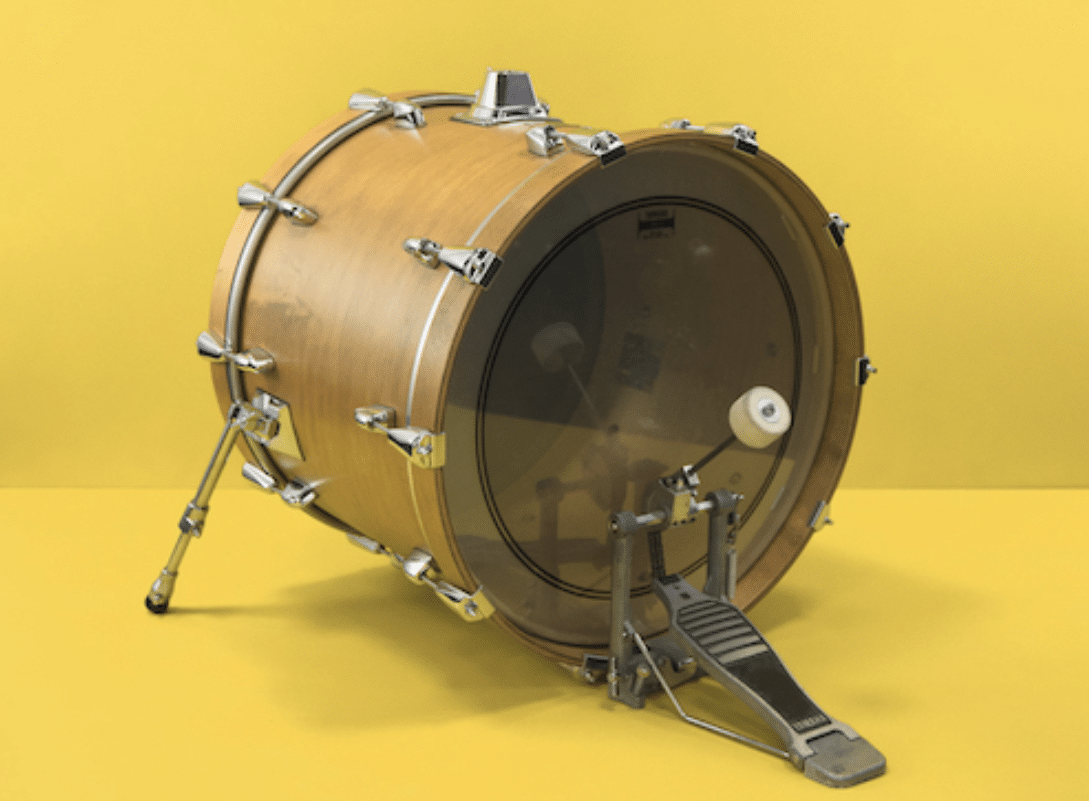
The kick drum, or bass drum, is the heartbeat of a drum pattern.
They provide the low-frequency thump that drives the rhythm forward.
It’s usually the most prominent drum sound in a pattern, creating a solid foundation for other drum sounds to play off.
-
The Snare Drum
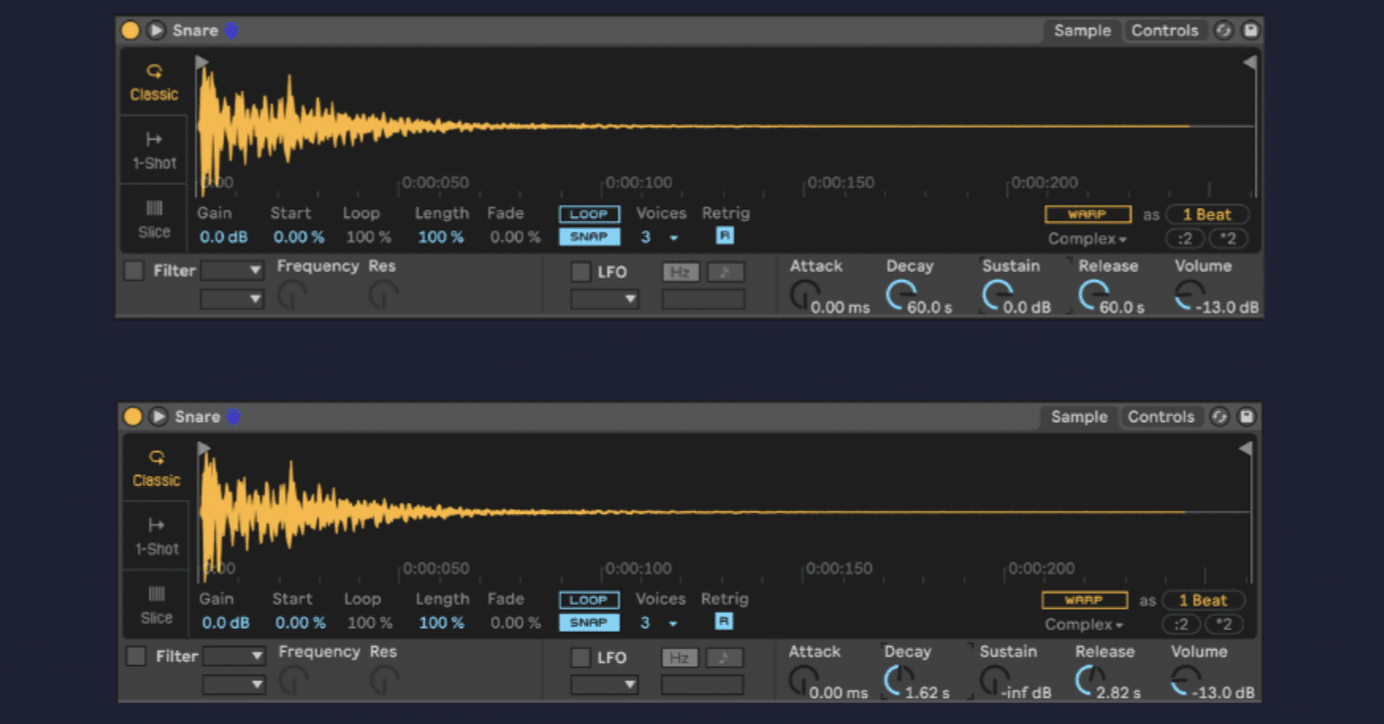
The snare drum serves as the counterpoint to the kick drum.
It has a higher frequency and a sharp, crisp sound that cuts through the mix.
In a standard drum pattern, the snare usually hits on the second and fourth beats.
This creates a back-and-forth conversation with the kick drum.
That perfect give-and-take captivates your listeners and makes them hit that replay button.
-
Hi-Hats
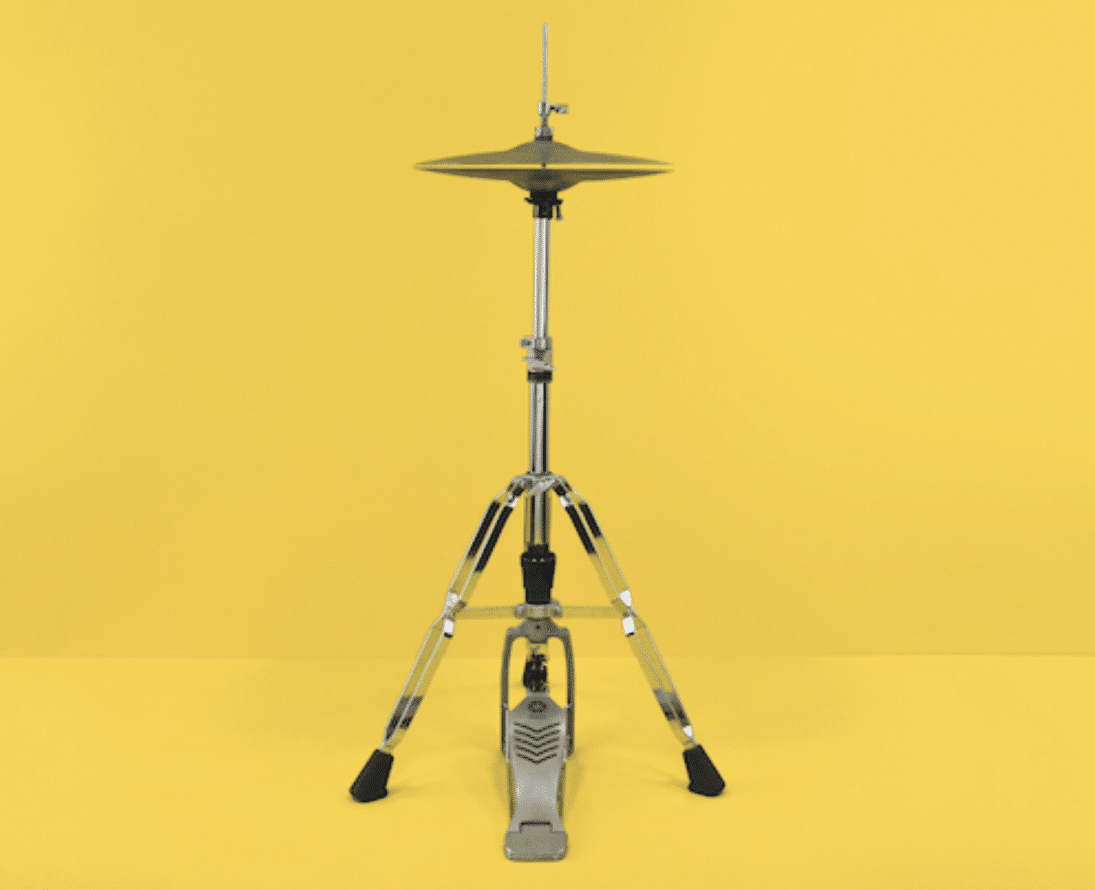
Hi-hats add a layer of high-frequency rhythm to a drum pattern.
They provide a steady stream of rhythm that keeps the pace and fills in the gaps between the kick and snare.
Depending on how they’re programmed, hi-hats can create a sense of urgency, relaxation, or anything in between.
-
Cymbals
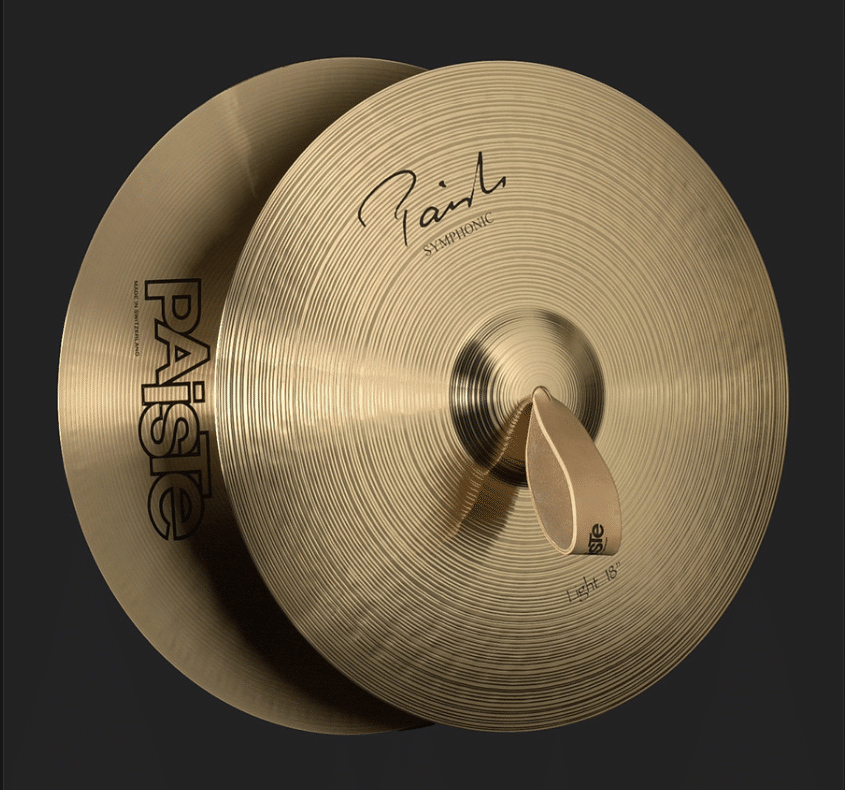
Cymbals, like ride and crash, provide accents and transitions in a drum pattern.
They’re used sparingly, but when used right, they can add a lot of dynamics and color to a drum pattern.
-
Drum Samples
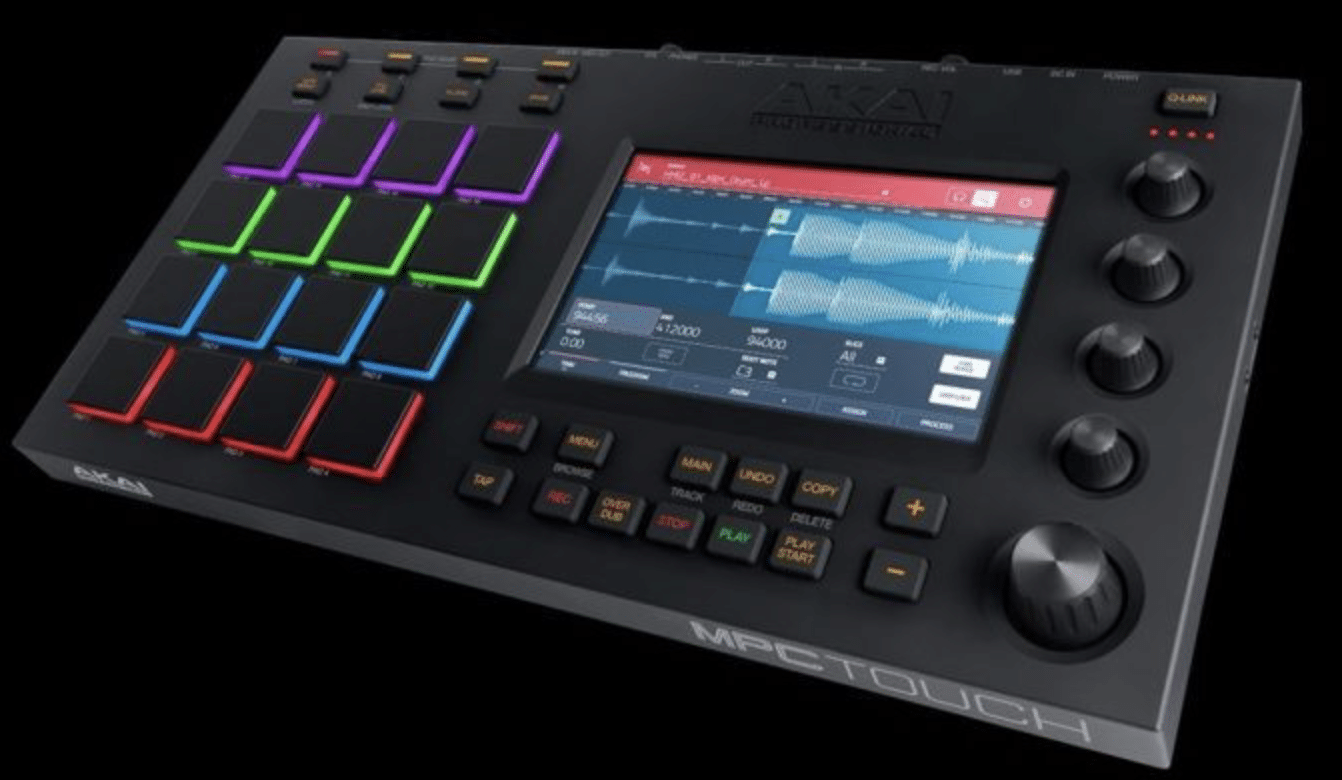
To get started with drum programming, you’ll need a collection of drum samples, like a snare sample, or sampled loops.
These are individual recordings of drum sounds that you can arrange to create drum patterns.
Sample packs are a great source of high-quality drum samples 一 covering a wide range of drum sounds and styles.
Make sure to choose professional samples that fit the style of music you’re producing; the right drum sounds can make or break a track.
This will ensure successful drum programming.
Drum Kits
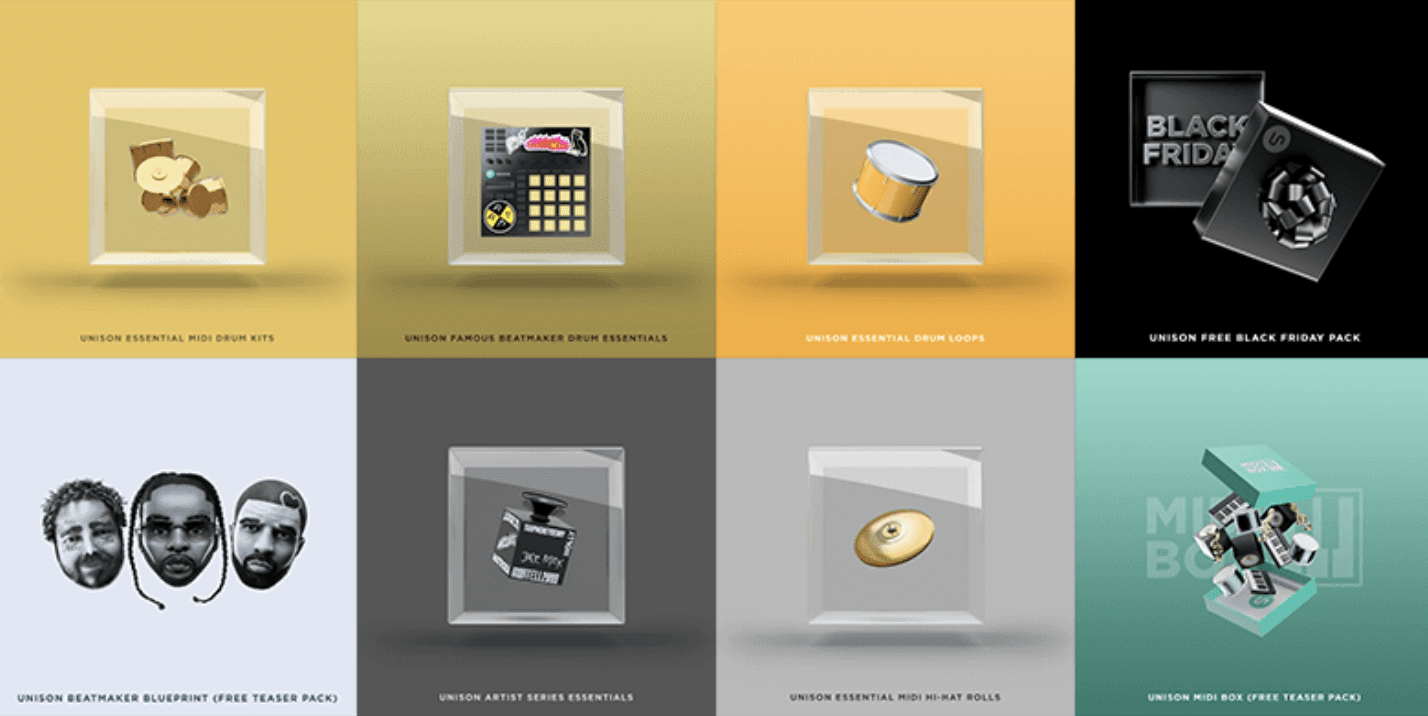
A drum kit (or drum set) is a collection of drums and cymbals that a drummer plays with sticks or brushes.
In drum programming, we use virtual drum kits 一 collections of drum samples that either mimic the sounds of a real drum kit or are comprised of samples.
The kick drum: is the largest drum in the kit.
It’s played with a foot pedal and produces a deep, low-pitched sound.
In a drum pattern, the kick drum lays down the entire foundation of the rhythm.
The snare drum: is a smaller drum that produces a sharp, high-pitched sound.
It’s often used to create accents and backbeats in a drum pattern.
In many genres, including hip-hop and tech house, the snare drum plays a crucial role in defining the groove of the track.
The hi-hat: is a pair of small cymbals that are mounted on a stand and played with a foot pedal.
The hi-hat can produce a variety of sounds depending on how it’s played, like a tight, crisp sound when closed, shushing sound when slightly open, and a sizzling crash when struck (and open).
Other elements of a drum kit include:
- Toms (mid-pitched drums used for fills and accents)
- Ride cymbals (used for steady rhythms and accents)
- Crash cymbals (used for dramatic accents and transitions)
When it comes to drum programming, it’s important to have a good selection of drum samples for each element of the drum kit.
Make sure to ensure your samples sound professional and intriguing.
This gives you the flexibility to create a wide variety of drum patterns and rhythms.
Drum Programming Basics
As we journey from the realm of drum programming basics, our next destination involves understanding how to program drum patterns and breathe life into programmed drums.
Good drum programming isn’t just about making a beat; it’s about creating a drum part that tells a story.
So, let’s move forward and dive into the crucial stage of setting up your DAW for drum-machine-style programming.
-
Setting Up Your DAW for Drum-Machine-Style Programming
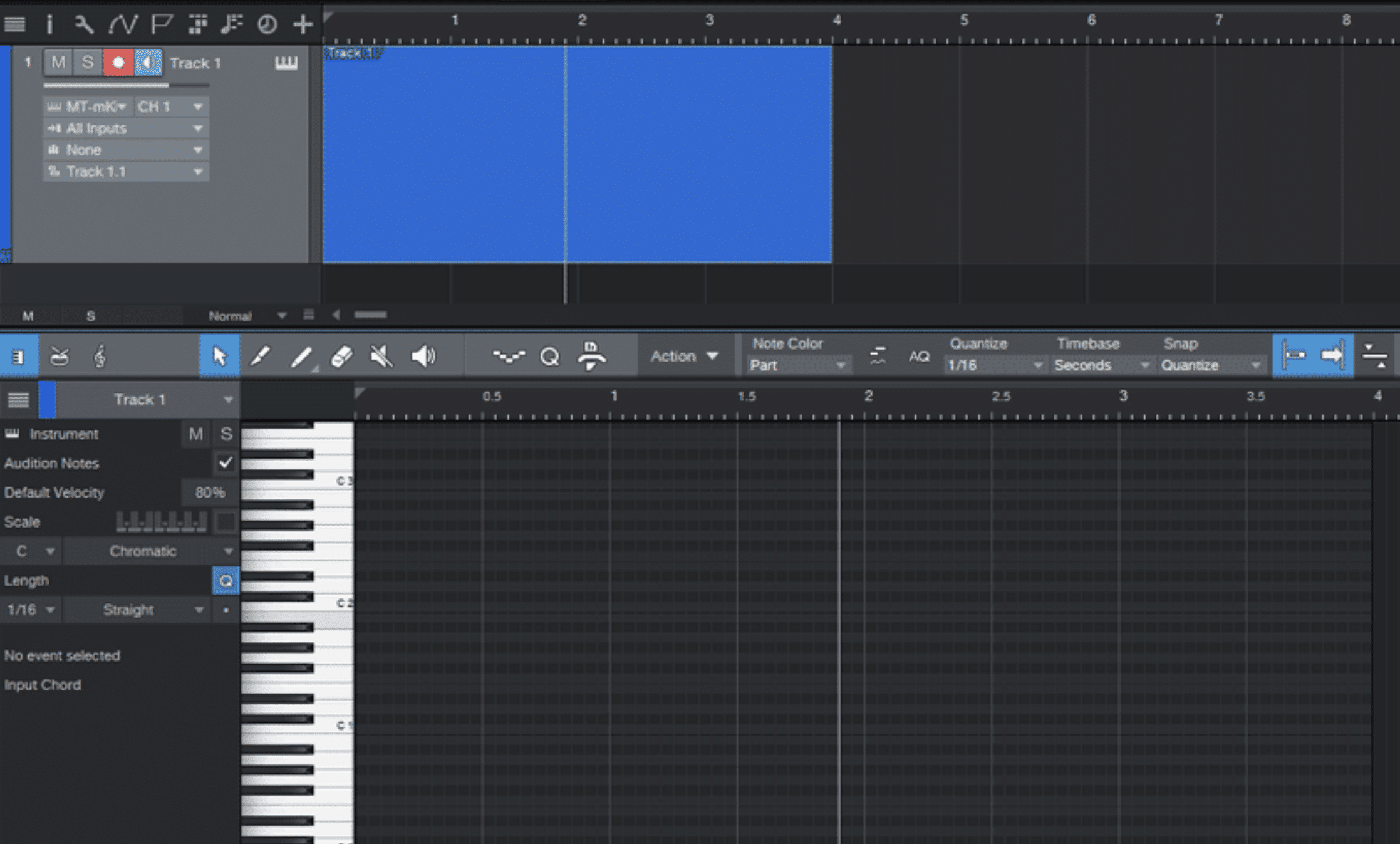
When setting up your DAW to operate more like a traditional (groove-based) machine, like used in drum synthesis, the first step is to select your sounds.
Your DAW can do virtually everything a drum machine can adjust parameters for each sound, like the:
In the context of drum programming, each individual drum sound or sample is usually referred to as a ‘voice.’
A typical drum machine will have voices for kick, snare, hi-hats (both open & closed), toms, and cymbals at a minimum.
Some drum machines offer more exotic percussive sounds like bongos, cowbells, shakers, and more.
Once you’ve selected your voices and either defined your style with samples or emulated a set of samples from a famous drum machine (e.g., the TR-808), you can start programming your pattern.
Most drum machines operate in a step-sequencer format 一 where you place each drum hit on a grid that represents your musical measure.
And even if it’s not displayed as step-based sequences like FL Studio, Ableton Live, or Logic’s new view, the piano roll functions in the same fashion.
-
The Grid

The grid (piano roll) will have different lines or sections for each voice, allowing you to create a full drum pattern.
It’s essential to set your tempo before you start programming your pattern (especially when using a MIDI keyboard).
-
The Tempo
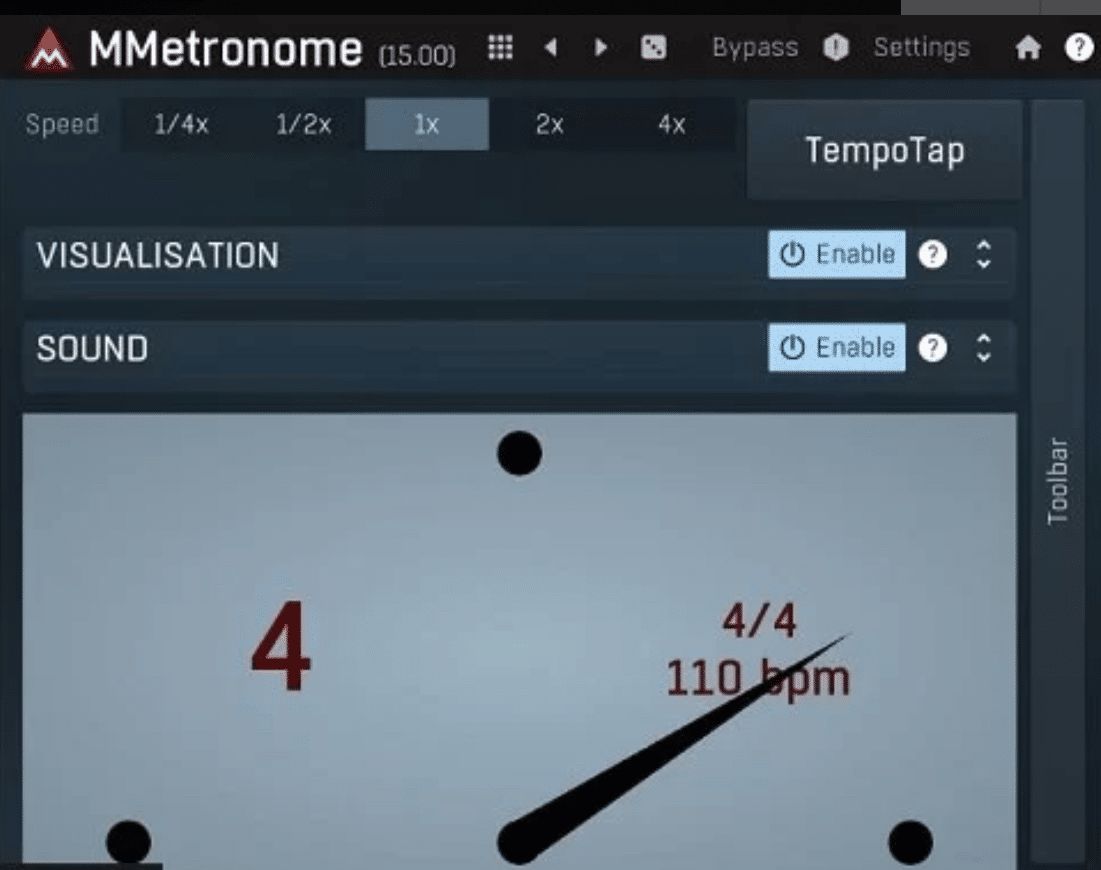
The tempo, measured in beats per minute (BPM), will dictate the pace of your drum pattern.
You can usually adjust the tempo with a dial or by manually entering the BPM.
After setting up your sounds and tempo, you can start inputting your rhythm.
You do this by activating specific steps on your sequencer or inputting/recording individual notes within the piano roll for each drum voice.
Once you’ve completed a sequence, you can play it back, make adjustments, and begin layering more complex rhythms.
-
Creating Your Own Drum Patterns
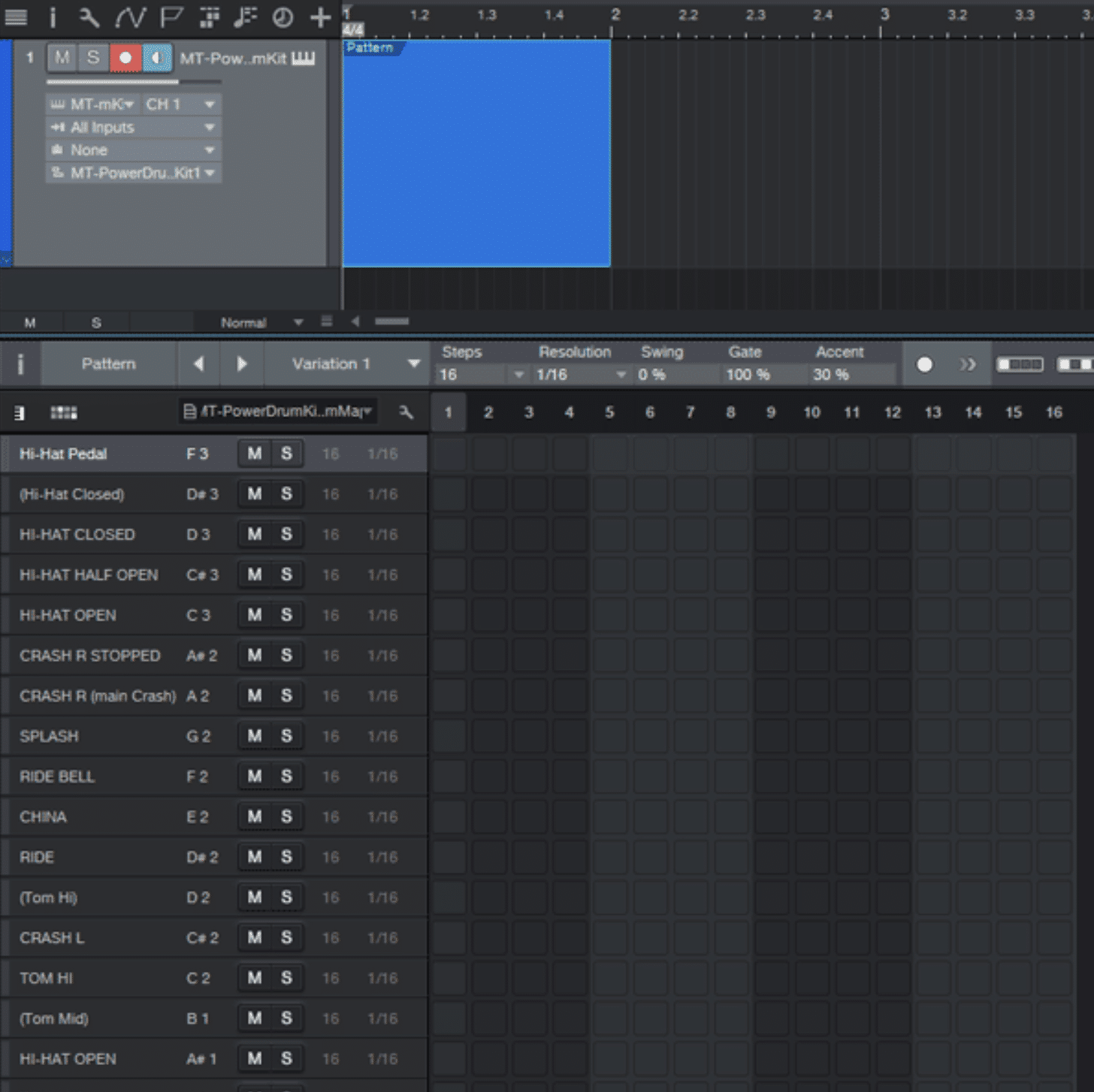
Once you’ve chosen your drum sounds, the next step is to create a basic drum pattern.
This is the backbone of your drum programming; the steady rhythm that drives the track forward.
STEP 1 一 Start with the kick drum.
Place the kick on the first beat of the measure, and experiment with adding additional kicks for variation.
In many genres, including hip-hop, trap, and tech house, the kick drum plays a steady four-to-the-floor rhythm.
STEP 2 一 Add the snare drum.
In most drum patterns, the snare hits on the second and fourth beats, providing the backbeat.
This is a good starting point, but feel free to experiment with different placements for added variation and syncopation.
STEP 3 一 Add the hi-hats.
The hi-hats typically play a steady stream of eighth notes, filling in the gaps between the kick and snare.
This creates a sense of momentum and drive.
STEP 4 一 Add cymbals and other percussion sounds for accents and transitions.
A well-placed cymbal crash can add excitement and energy to a drum pattern, while a tom fill can signal a transition or change in the music.
The key to creating a good drum pattern is balance:
- The kick and snare: provide the foundation.
- The hi-hats: add momentum.
- The cymbals and percussion: add color and dynamics.
Each element has its role to play, and they all work together to create a super compelling rhythm.
Learning their unique sound and purpose is key to becoming a drum programming master.
Hip-hop Drum Programming
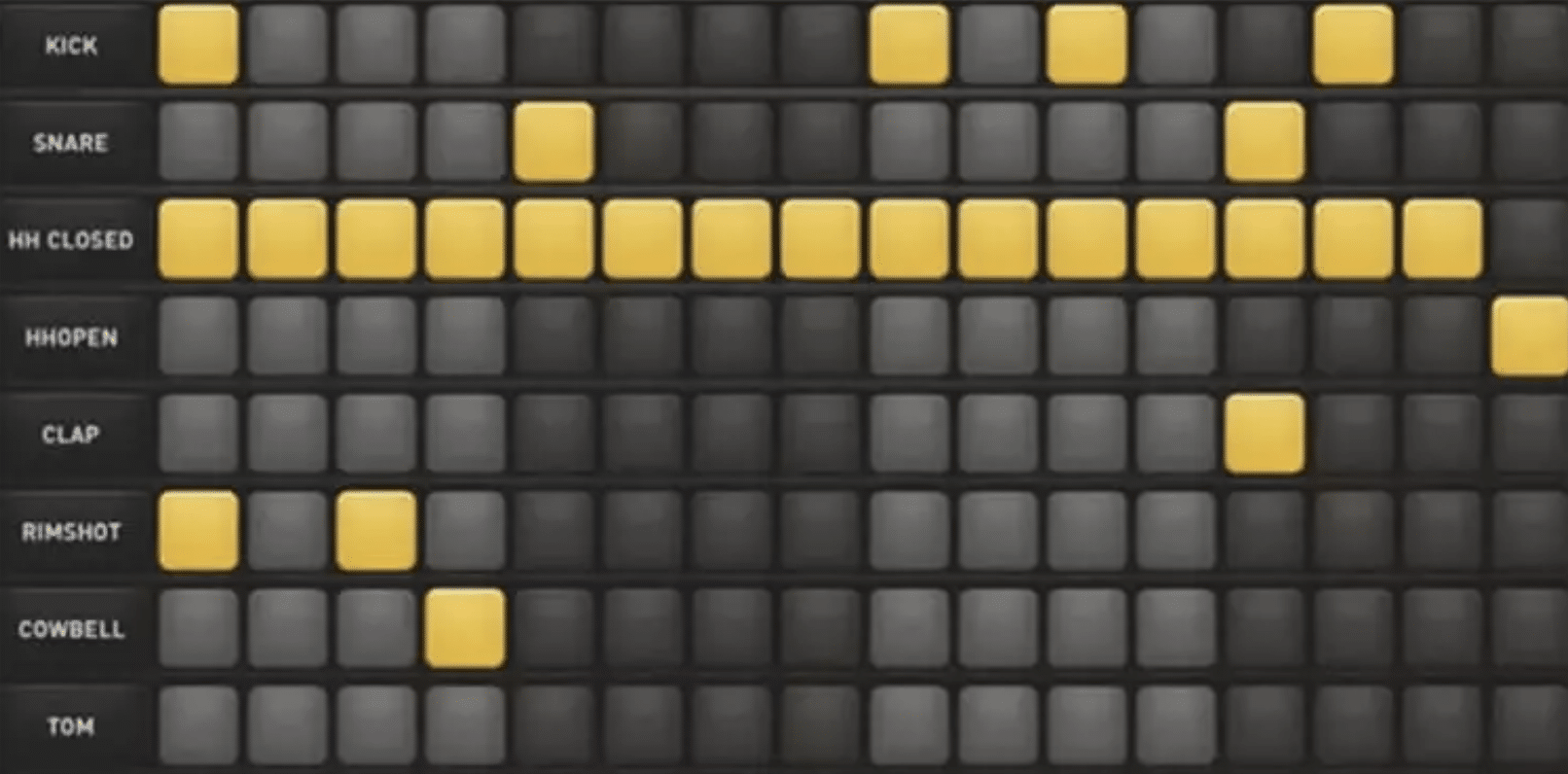
Hip-hop music is widely recognized for its unique and iconic drum patterns.
When it comes to programming drums for hip-hop, it’s important to capture the genre’s distinct rhythmic feel.
Unlike certain tech house music, hip-hop drum patterns are heavily reliant on the kick and snare.
- The kick 一 Often lands on the first and third beat of the bar.
- The snare 一 Hits on the second and fourth (also known as the backbeat).
This structure creates a steady, bouncing rhythm that is fundamental to the genre.
In addition to the basic kick-snare pattern, hip-hop often utilizes hi-hats and other percussive elements to add a layer of complexity.
- Hi-hats 一 Usually follows an eighth or sixteenth-note pattern.
- Percussive sounds like shakers or tambourines 一 Can also provide a richer rhythmic texture.
What truly characterizes hip-hop drum programming, though, is its use of ‘swing‘ or a good ‘groove.’
This refers to a slight rhythmic delay applied to certain beats (most commonly the sixteenth notes) to create a looser feel as human drummers provide.
Applying swing to your drum patterns can help achieve that distinctive hip-hop rhythm.
Further Mastering the Kick Drum & Snare Drum
Now, let’s dive into the core of the best: how to master the kick drum and snare drum.
Understanding these factors is crucial in any style, as their unique interplay forms the heartbeat of your track.
-
Kick Drum Essentials
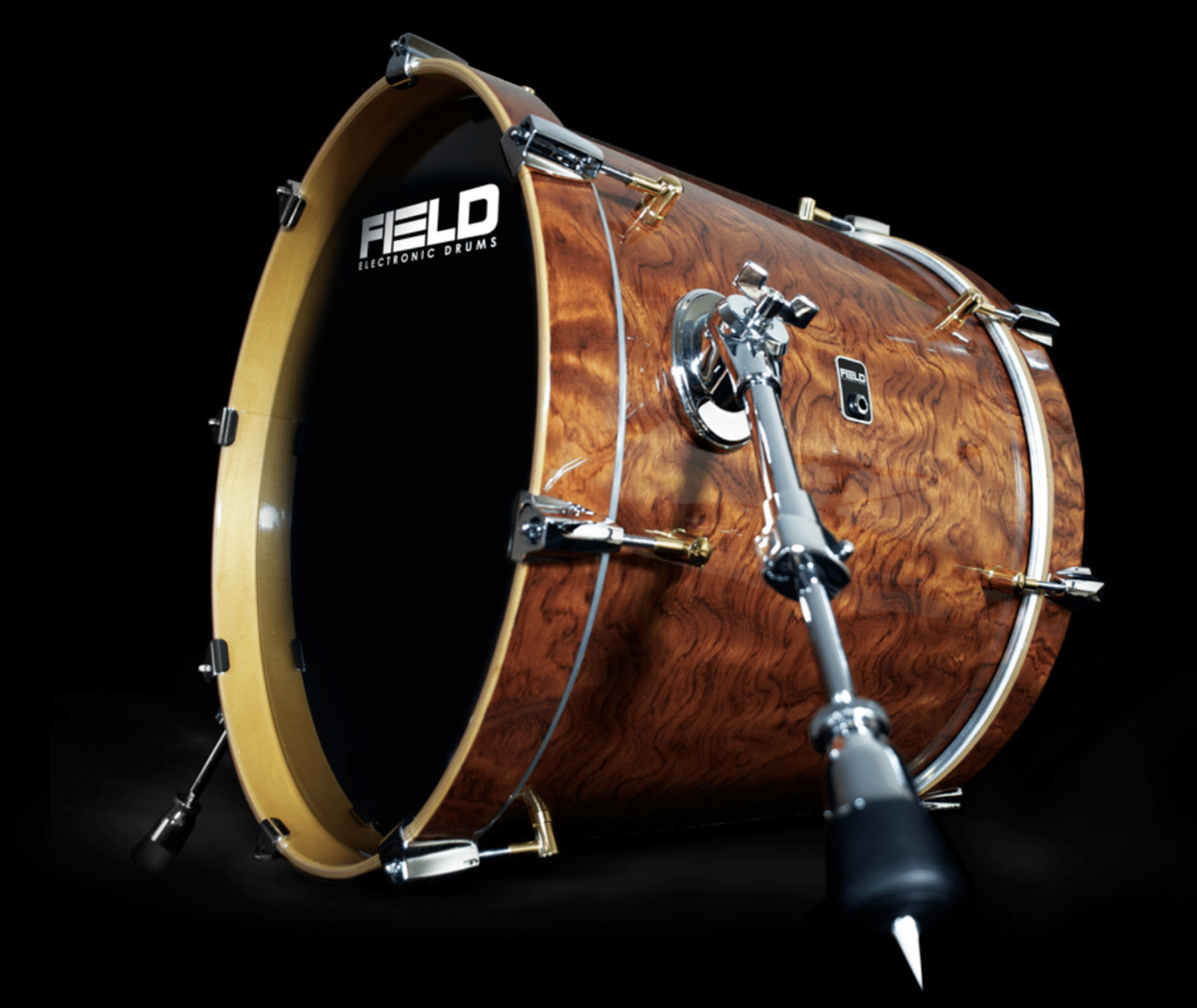
The kick drum, also known as the bass drum, is a crucial part of any drum pattern.
It provides the fundamental rhythm and drives the pace of the track.
In most drum patterns, the kick drum lands on the first beat of the bar, also known as the ‘downbeat.’
This helps establish the rhythm and provides a reference point for the rest of the pattern.
In addition to the downbeat, the kick drum often hits on other beats to create a more complex rhythm.
The specific pattern will depend on the genre of music, like pop or r&b 一 but it’s common to have additional kick hits on the third beat of the bar or the ‘and’ counts between beats.
The sound of the kick drum is equally important to ensure it doesn’t fall flat, just ask your favorite artists.
A good kick drum should have a strong, clear punch that can cut through the mix.
It should also have a deep, resonant low-end to provide the bottom end of your rhythm.
Many drum machines and software plugins allow you to tweak the sound of your kick drum.
This might involve:
- Adjusting the fundamental pitch
- Adjusting the decay
- Adjusting the tone
- Layering multiple kick sounds together
Mastering the kick drum is essential for creating powerful, compelling drum patterns.
Spend time experimenting with different kick patterns and sounds to find what works best for your music.
-
Snare Drum Pattern Basics

The snare drum provides the counterpoint to the kick drum 一 usually hitting on the second and fourth beats in a measure to provide a backbeat.
It adds high-frequency energy and syncopation to the beat.
The sound of your snare can dramatically affect the feel of your track.
Experiment with different snare samples to find one that fits the mood of your song.
- For a classic hip-hop feel 一 Choose a snare with a lot of “crack” and high-end frequency content.
- For a more electronic or dance-oriented track 一 A synthesized snare with a punchy, sustained tone could be the right choice.
The snare pattern is another crucial aspect of your drum programming (and drum mixing, for that matter).
While the kick drum often provides a steady pulse, the snare can be used for syncopation and complexity.
By placing snare hits off the beat or in unexpected places, you can create a complex, engaging rhythm that will keep your listeners on their toes.
Also, consider using ghost notes, a rim shot, or a missed beat in your snare patterns.
Ghost notes are quieter, less emphasized snare hits that can add a subtle layer of complexity to your rhythm.
These are particularly common in genres like funk and jazz but can be used effectively in any genre to add a layer of rhythmic intricacy.
Pro Tip
You should also consider the rhythmic relationship between your kick and snare.
If your kick pattern is simple and steady, you might use a more complex snare pattern to create interest.
Conversely, if your kick pattern is complex and syncopated, a simpler snare pattern might provide a necessary sense of stability.
Hi-Hats & Cymbals: Giving Life to Your Drum Patterns
Having tackled the dynamics of kick and snare, we now turn our attention to the details that can bring your beat to life: the hi-hats and cymbals.
In this section, we’ll explore how these often-overlooked components can add depth, color, and groove to your beats
-
Hi-Hat Rhythms
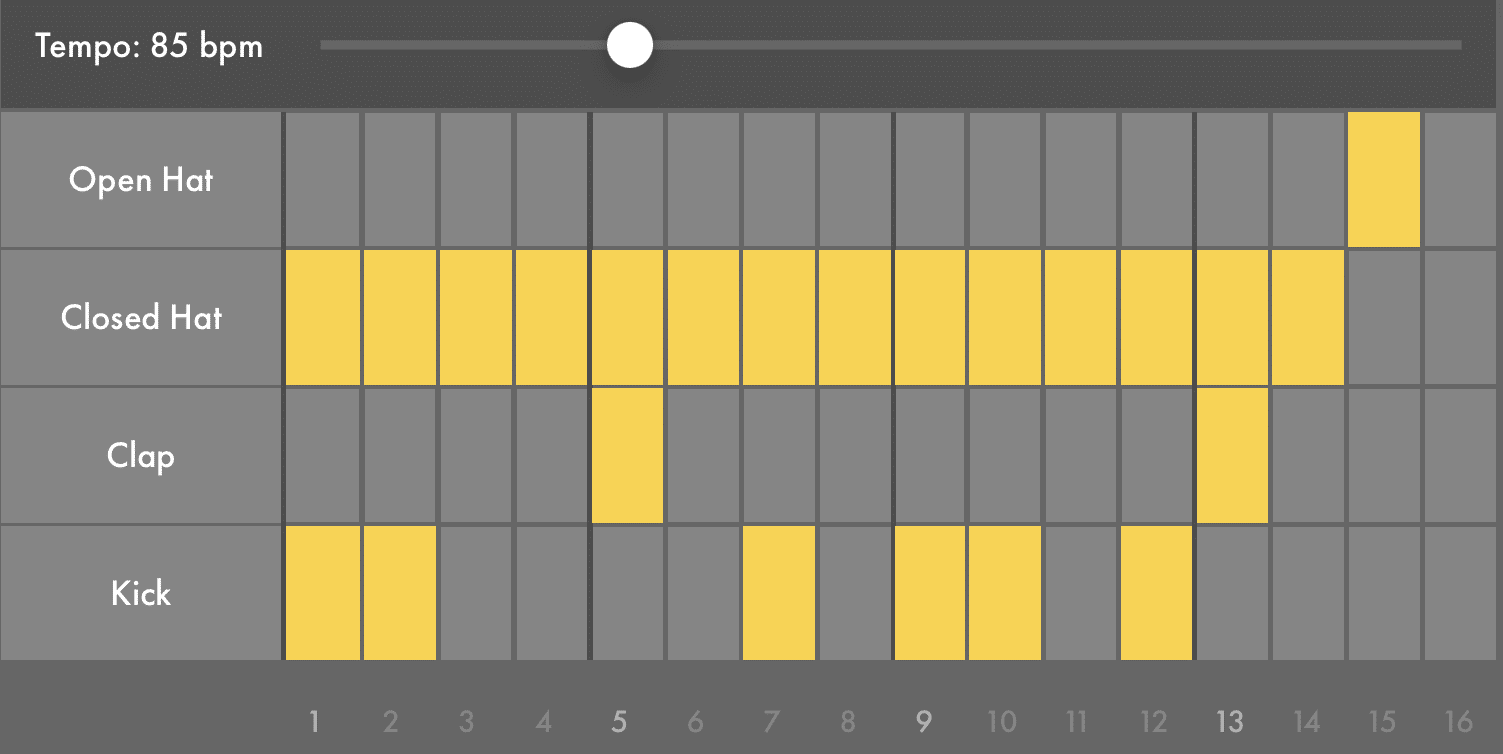
Hi-hats play a crucial role in drum programming, often providing a steady rhythm that helps to drive the track forward.
In many genres and subgenres, the hi-hats play a stream of eighth notes, creating a sense of momentum and energy.
Experiment with different hi-hat patterns to create different rhythmic feels.
- For a straight-ahead, driving feel 一 Have your hi-hats play a steady stream of eighth notes.
- For a more relaxed, groovy feel 一 Have your hi-hats play a syncopated rhythm, with accents on the off-beats.
Don’t forget about open hi-hats…
An open hi-hat has a longer, more sustained sound than a closed hi-hat, and can be used to add a splash of high-frequency energy to your drum pattern.
Try placing an open hi-hat on the off-beat for a classic disco feel, or at the end of a measure for a dramatic lead-in to the next section of your song.
Like the snare, the hi-hat can also make effective use of ghost notes.
You’d have to listen closely, as these are quieter, less emphasized hi-hat hits that can add a subtle layer of complexity to your rhythm.
Try adding a few ghost notes to your hi-hat pattern and see how it changes the feel of your drum pattern.
-
Exploring Ride Cymbals

The ride cymbal is another crucial element in many drum patterns.
Like the hi-hat, the ride cymbal often plays a steady stream of eighth notes, adding a high-frequency rhythmic element that can help to drive your song forward.
The sound of your ride cymbal can have a big impact on the feel of your track.
- A bright, piercing ride cymbal 一 Appropriate for a high-energy rock track.
- A darker, mellower ride cymbal 一 More suitable for a laid-back jazz or hip-hop track.
Experiment with different ride cymbal patterns to create different rhythmic feels.
For example, you could have your ride cymbal play a syncopated rhythm to create a sense of swing, or a steady stream of eighth notes for a driving, rock-and-roll feel.
-
Combining Hi-Hats & Cymbals with Kick & Snare
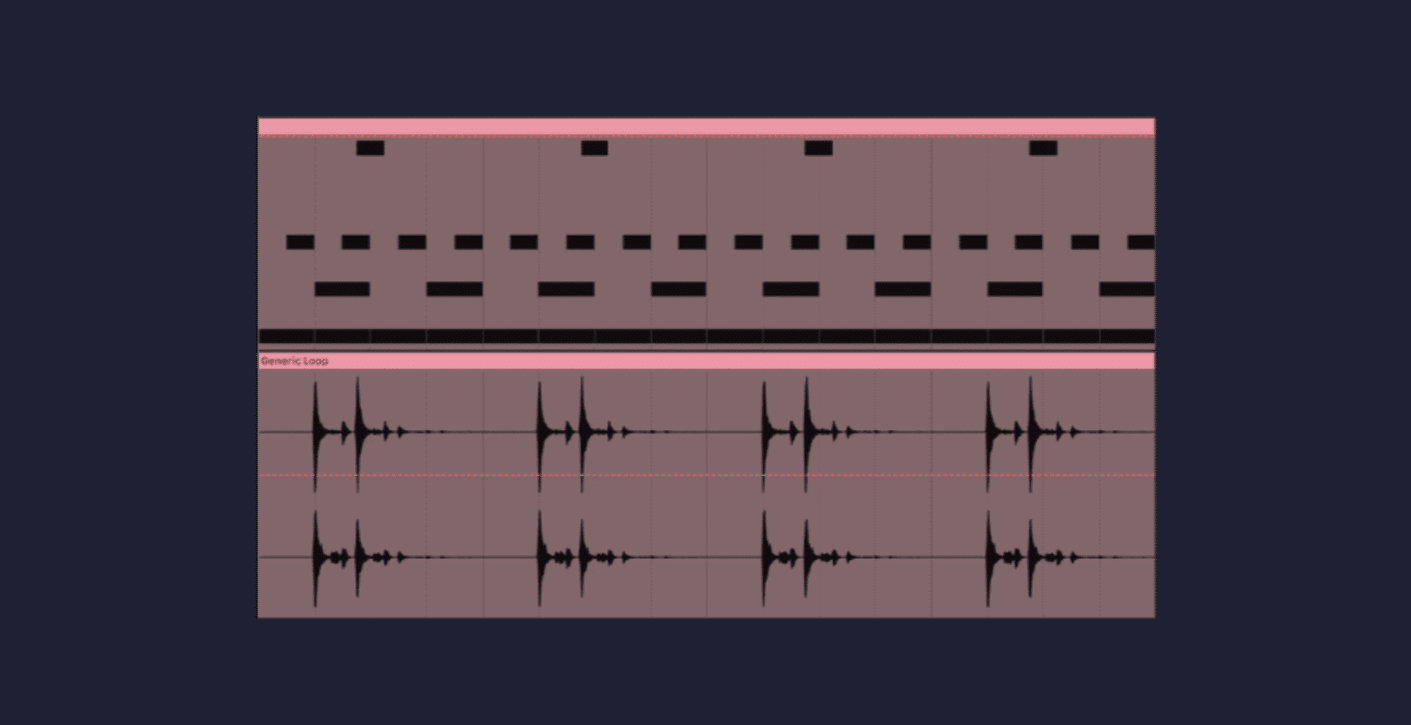
Now that you’ve explored the hi-hats, ride cymbals, kick & snare individually, it’s time to start thinking about how they all work together.
Remember, the goal of drum programming is not just to create a cool drum pattern, but to create a rhythm that supports and enhances your song.
Start by laying down a basic kick and snare pattern 一 this will be the backbone of your drum pattern, providing the basic rhythmic foundation.
Next, add in your hi-hats.
As you add your hi-hats, listen to how they interact with the kick and snare.
Try asking yourself:
- Are they enhancing the groove?
- Or, are they clashing with the rhythm of the kick and snare?
If necessary, adjust your hi-hat pattern until it complements the kick and snare, rather than fighting against them.
Once you’re happy with your hi-hat pattern, try adding in a ride cymbal.
The ride can add a layer of high-frequency rhythmic complexity to your drum pattern.
Again, listen to how the ride interacts with the rest of your drum pattern 一 if it’s enhancing the groove, great. If not, don’t be afraid to make adjustments.
Understanding & Using Syncopation
Upon mastering the essentials of drum programming and the unique dynamics of the hi-hats and cymbals, we are now ready to delve into the rhythm-altering world of syncopation.
-
What is Backbeat Syncopation
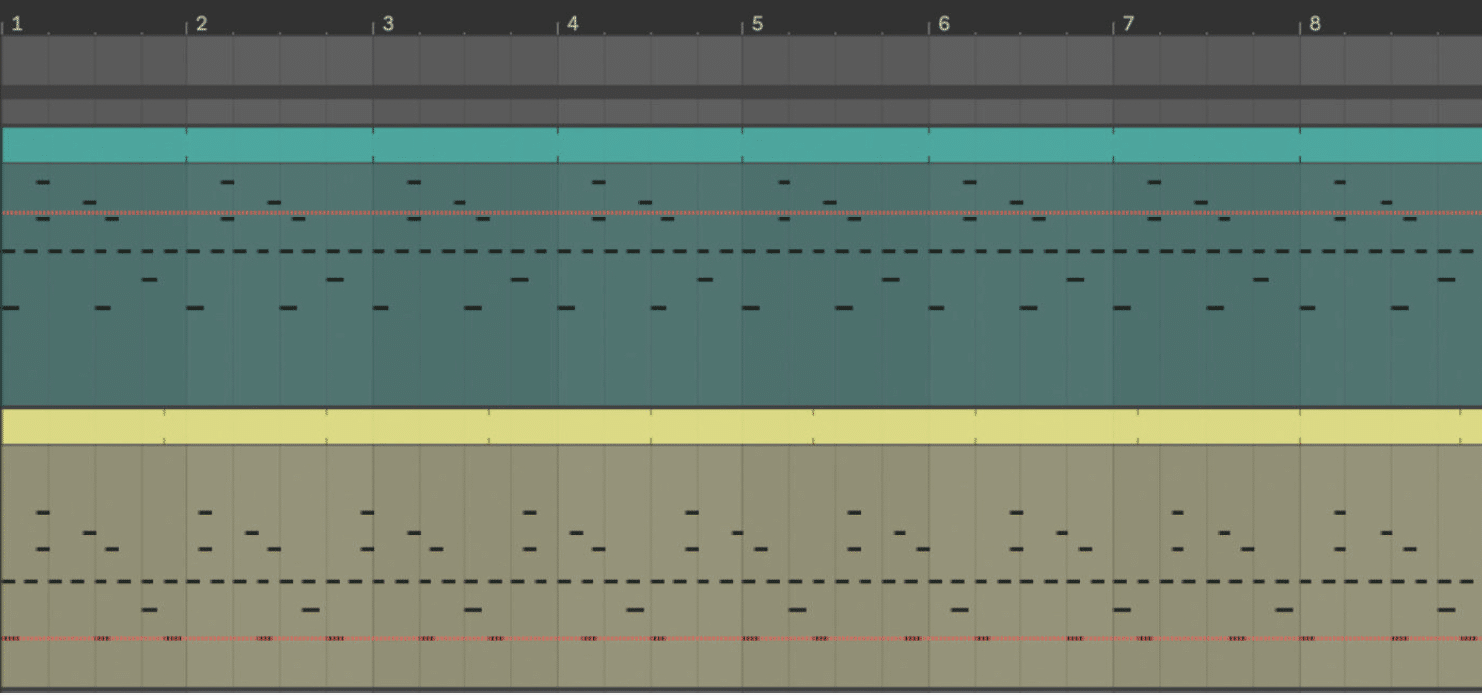
Syncopation is a rhythmic technique where you emphasize the off-beats or the beats that are not typically emphasized in a straightforward rhythm.
One of the most common types of syncopation is backbeat syncopation.
Backbeat syncopation emphasizes the second and fourth beats (in 4/4 time) or the third beat (in 3/4 time).
It is a foundational element of many types of music 一 from rock, hip-hop, latin music and pop to funk and jazz.
Also, it creates a sense of forward momentum and can make your rhythms feel more dynamic and engaging.
To experiment with backbeat syncopation in your drum patterns, try:
- Emphasizing the second and fourth beats in a 4/4 pattern.
- Emphasizing the third beat in a 3/4 pattern.
You can do this by making these beats louder, by placing a snare hit or a cymbal crash on these beats, or by using other techniques to draw attention to these beats.
Backbeat syncopation can be a powerful tool as a music producer, but like all tools, it should be used judiciously.
Too much syncopation can make your rhythms feel chaotic and hard to follow.
Remember, the goal of your drum programming is to support your song, not to show off your rhythmic chops.
-
Implementing Syncopation in Your Drum Patterns

Implementing syncopation in your drum patterns can add a level of sophistication and elevation to your music.
The placement of a snare hit or kick drum hit in an unexpected place can bring out a groove and add a swing to your track.
To start adding syncopation to your drum patterns or drum beat, begin with a simple beat and identify where the backbeats are.
If you’re working in 4/4 time 一 these will typically be the second and fourth beats of the measure.
Try moving some of your snare hits or kick drum hits to these beats and see how it changes the feel of the pattern.
Once you’re comfortable with backbeat syncopation, you can start experimenting with more complex forms of syncopation.
Try emphasizing the “and” of each beat with MIDI notes (in other words, the eighth-note offbeats), or even the sixteenth-note offbeats.
This can create a sense of rhythmic tension and release that can make your drum patterns more exciting and dynamic.
Finally, remember that syncopation doesn’t have to be limited to your snare and kick drums.
You can also use syncopation in your hi-hat patterns, your cymbal patterns, and even in your melodic and harmonic elements.
The possibilities are truly endless.
The Art of Drum Loop Variation
Having delved deep into the intricacies of drum programming, kick and snare balancing, and the power of syncopation, let’s explore the realm of drum loop variations.
-
Basic Drum Loops: Variations
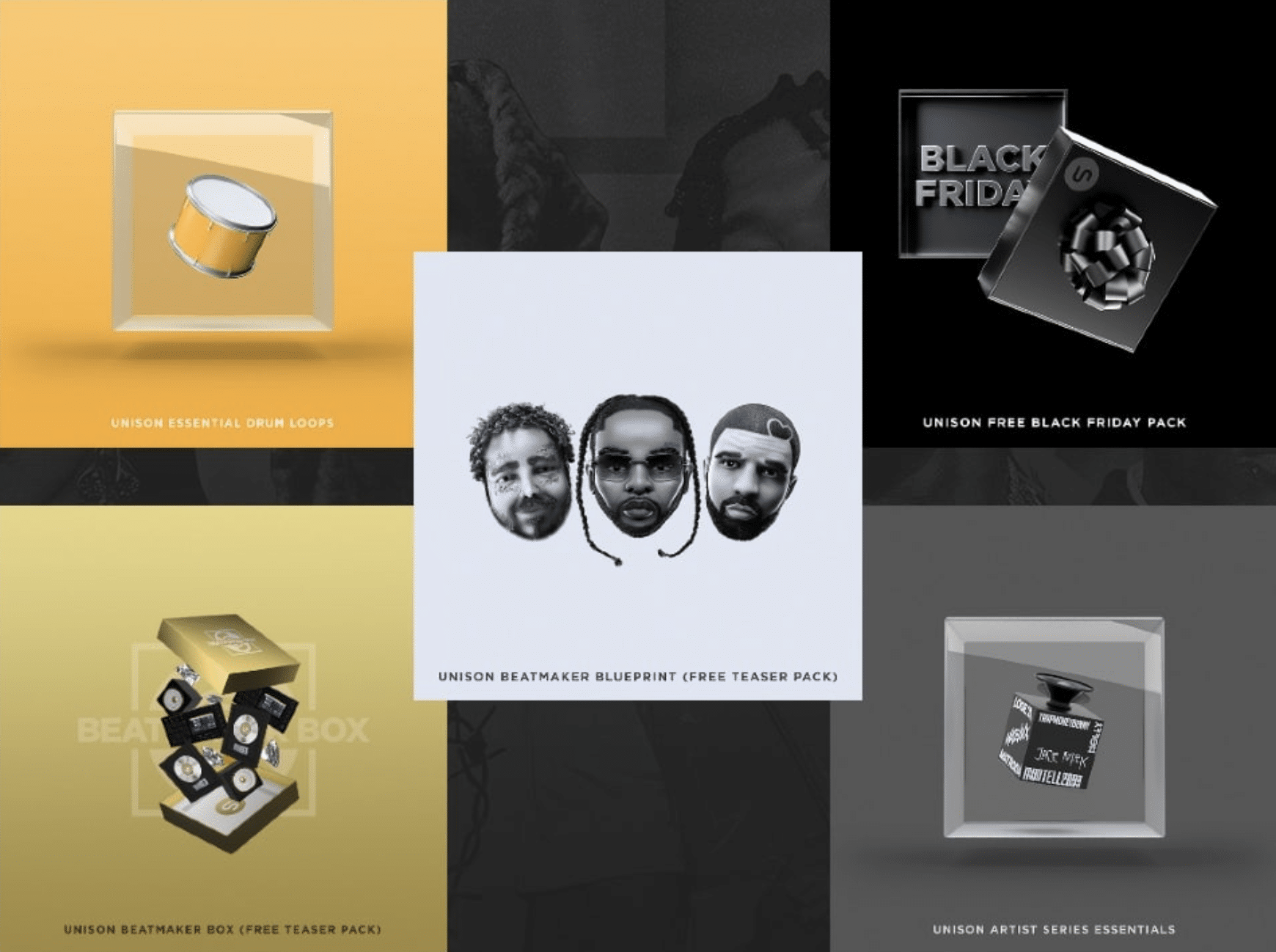
Once you’ve created a basic drum loop, there are many ways you can create variations to keep your rhythms interesting.
One of the simplest ways is to change the drum pattern subtly every few measures like most genres do (like house music, trap, etc.).
For instance, you might add or subtract a kick or snare hit, or change the pattern of your hi-hats.
These subtle differences can help to keep your sampled loops from becoming too repetitive and predictable.
Another simple technique is to add fills or breaks at the end of every few measures.

- A fill 一 A short, one-measure drum pattern that can help to signal the end of a musical phrase and lead into the next one.
- A break 一 A short section where most or all of the instruments drop out (minus the drums), creating a sense of space and anticipation.
Many sample packs contain drum loops of 1-2 bar breaks and fills, if you find creating your own too time-consuming.
Finally, you might consider changing the sound of your drums subtly throughout your track.
This could mean adjusting the mix of your drums (e.g., changing the relative volumes of your kick, snare & hi-hats) or changing the drum samples you’re using.
Changing the sound of your drums can help to create a sense of progression and development in your track, even if the drum pattern stays the same.
It’s important to always remember that these variations should appropriately serve the song.
Too much variation can make your drum pattern feel chaotic and disjointed.
The goal is to strike a balance between:
- Repetition (which can create a sense of groove and stability).
- Variation (which can keep the rhythm interesting).
Once you get that down, you’ll be able to create the perfect drum pattern every single time.
-
Advanced Techniques for Drum Loop Variation
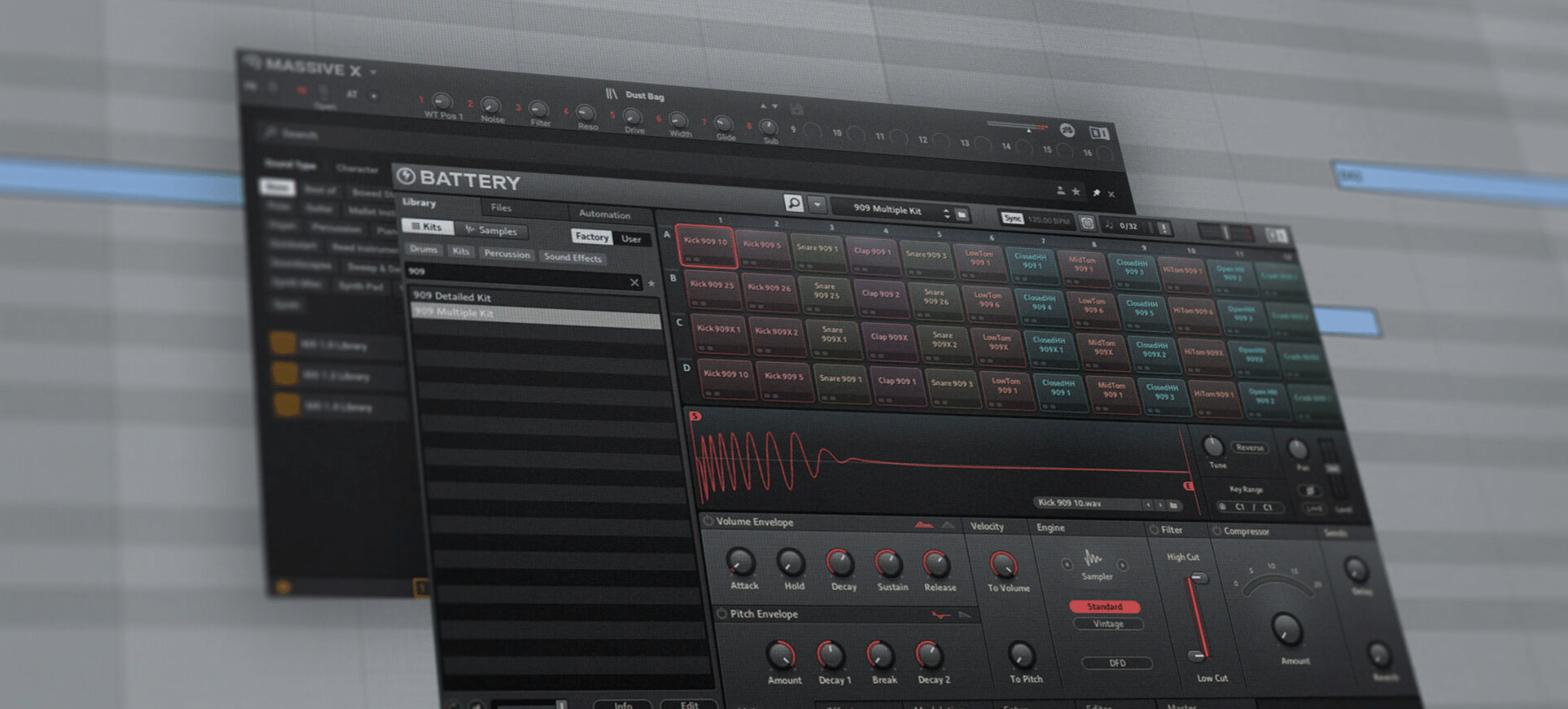
As you become more comfortable with drum programming, you can start to experiment with more advanced techniques for drum loop variation.
One such technique is polyrhythm, where two or more conflicting rhythms are played simultaneously.
For instance, you might program:
- Your hi-hats to play a pattern based on triplets (three notes per beat).
- Your kick and snare to play a straight 4/4 pattern.
This creates a complex, overlapping rhythm that can add a lot of interest to your drum loop.
Another advanced technique is rhythmic displacement, where you shift a rhythmic pattern by a beat or a half-beat.
This can create a sense of surprise and unpredictability in your rhythms, as the listener’s expectations are subtly subverted.
Finally, you might experiment with changing the velocity (or volume) of your drum hits.
By making some hits louder and others softer, you can create a sense of dynamic variation and make your drum patterns feel more “human.”
The Importance of Mixing in Drum Programming
In the world of music production, the mixing process is where the magic truly happens, breathing life into raw audio tracks.
This stage is especially crucial in drum programming, where individual sounds must coalesce into a coherent, rhythmically compelling whole.
We’ll first start with understanding the rudiments of mixing drum sounds, aiming for clarity, depth, and an alluring sonic character.
-
How to Properly Mix Drum Sounds
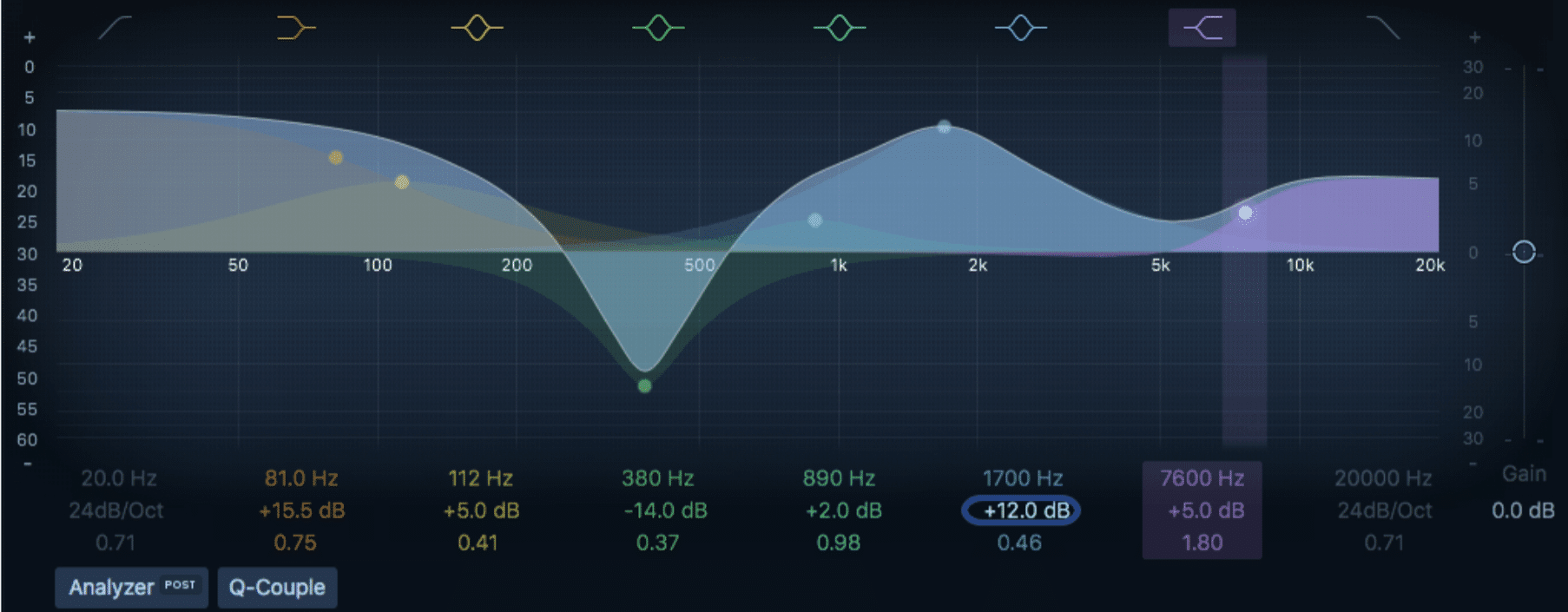
When you’re programming drums, it’s important not only to create interesting rhythms but also to mix your drum sounds effectively.
- A well-mixed drum track 一 Can make your rhythms sound punchy and powerful.
- A poorly mixed drum track 一 Can make them sound muddled and weak.
One of the most important aspects of mixing drums is balancing the levels of your kick, snare, and hi-hats.
Generally, you want your kick and snare to be the loudest elements of your drum track, as they provide the rhythmic backbone of your song.
Your hi-hats should be quieter, as they provide a layer of rhythmic detail on top of the kick and snare.
Another important aspect of mixing drums is EQ.
By adjusting the equalization of your drum sounds, you can make them sound brighter or darker, punchier or smoother.
A good starting point is to:
- Boost the low frequencies of your kick drum to give it a powerful thump.
- Boost the high frequencies of your snare and hi-hats to give them a crisp snap.
Finally, you might consider adding some reverb to your drum sounds.
A little bit of reverb can make your drums sound more natural and spacious, but too much can make them sound distant and washed out.
As always, use your ears and trust your judgment.
-
Ensuring Your Drums Fit in the Mix
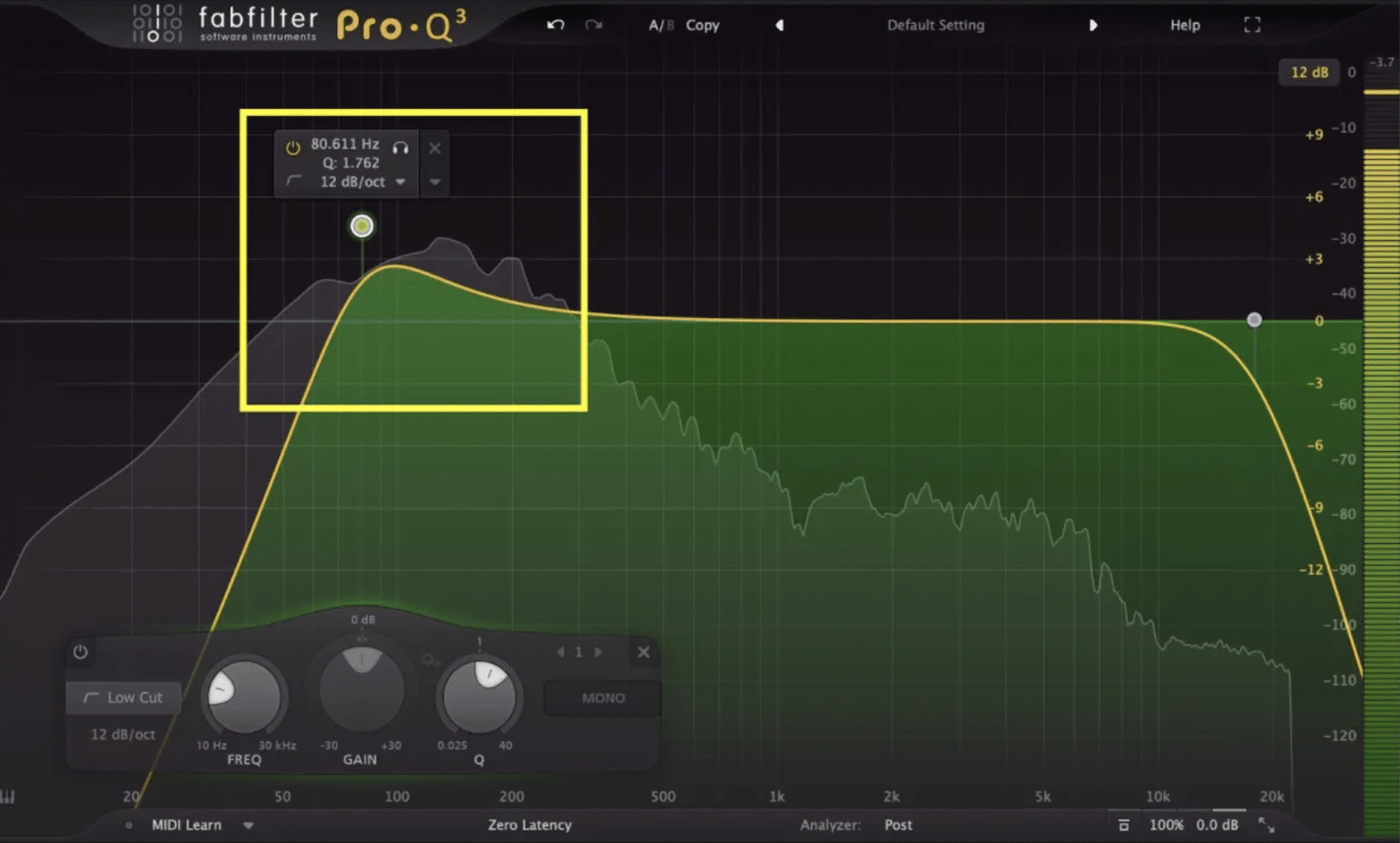
Once you’ve mixed your drum sounds to your liking, it’s important to make sure they fit well within the overall mix of your track.
Even the most interesting and well-mixed drum pattern can sound out of place if it doesn’t fit with the other elements of your song.
One of the key aspects of fitting your drums into the mix is making sure they occupy their own space in the frequency spectrum.
If your drum sounds are competing with other elements of your track for the same frequency space, they can end up sounding muddled and indistinct.
For instance, if you have a bass track that occupies the low frequencies, you might want to EQ your kick drum to emphasize its midrange frequencies.
This way, it can cut through the mix without clashing with the basic foundation.
Another key aspect is balance:
- If your drums are too loud 一 They can overpower the other elements of your track.
- If they’re too quiet 一 They can get lost in the mix.
Use your ears and your judgment to find the right balance.
Remember, the goal of mixing is not to make your drums (or any other element of your track) sound good in isolation but to make them work well within the context of your song.
Always listen to your mix as a whole, rather than focusing too much on individual elements.
Remember that mixing is a skill that takes time and practice to develop.
Don’t be discouraged if your first mixes don’t sound as good as you’d like them to.
Final Thoughts
Drum programming is an integral aspect of modern music production that grants musicians the power to construct compelling rhythmic foundations for any genre.
By understanding all the techniques mentioned in today’s article, you can now create dynamic and engaging beats that will bring your music to life.
One way to make the process even more efficient and creative is to incorporate advanced tools like Drum Monkey.
This software tool has revolutionized drum programming with its intuitive interface and smart algorithms.
It allows you to experiment with different patterns, syncopations, and variations, all while ensuring that your beats remain in the groove.
But remember, the knowledge and techniques you’ve learned in this article are just the start…
The realm of drum programming is vast, with infinite possibilities for creativity.
So, keep exploring, keep practicing, and most importantly, keep making music.
Until next time…







Leave a Reply
You must belogged in to post a comment.